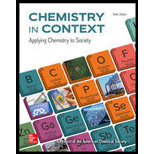
(a)
Interpretation:
If an ignition source is present and in which solvent vapors will catch fire at room temperature has to be found
Concept introduction:
Flammable: It is a property of a material relating how easily the material ignites (or) sustains a combustion reaction.
Flash point: Flash point of a liquid is the lowest temperature at which it gives off enough vapour to from an ignitable mixture with air.
Ignition: It is a flammable mixture may be caused by flammable mixture coming in content with a source of ignition with sufficient energy (or) the gas reacting a temperature high enough to cause the gas to autoignite.
(b)
Interpretation:
The auto ignition temperatures of the solvents found in Dr. Thompson’s laboratory and any of these solvents combust without presence of an outside source of ignition, the reason behind this has to be explained.
Concept introduction:
Flammable: It is a property of a material relating how easily the material ignites (or) sustains a combustion reaction.
Ignition: It is a flammable mixture may be caused by flammable mixture coming in content with a source of ignition with sufficient energy (or) the gas reacting a temperature high enough to cause the gas to autoignite.
Autoignition: The auto ignition temperature (AIT) corresponds to the minimum temperature at which the vapour spontaneously ignites, even in the absence of an ignition source.
Want to see the full answer?
Check out a sample textbook solution
Chapter 14 Solutions
Chemistry In Context
- Assign the functional group bands on the IR spectra.arrow_forwardFind the pH of a 0.120 M solution of HNO2. Find the pH ignoring activity effects (i.e., the normal way). Find the pH in a solution of 0.050 M NaCl, including activityarrow_forwardPlease help me answer these three questions. Required info should be in data table.arrow_forward
- Draw the major organic substitution product or products for (2R,3S)-2-bromo-3-methylpentane reacting with the given nucleophile. Clearly drawn the stereochemistry, including a wedged bond, a dashed bond and two in-plane bonds at each stereogenic center. Omit any byproducts. Bri CH3CH2O- (conc.) Draw the major organic product or products.arrow_forwardTartaric acid (C4H6O6) is a diprotic weak acid. A sample of 875 mg tartaric acid are dissolved in 100 mL water and titrated with 0.994 M NaOH. How many mL of NaOH are needed to reach the first equivalence point? How many mL of NaOH are needed to reach the second equivalence point?arrow_forwardIncluding activity, calculate the solubility of Pb(IO3)2 in a matrix of 0.020 M Mg(NO3)2.arrow_forward
- Order the following series of compounds from highest to lowest reactivity to electrophilic aromatic substitution, explaining your answer: 2-nitrophenol, p-Toluidine, N-(4-methylphenyl)acetamide, 4-methylbenzonitrile, 4-(trifluoromethyl)benzonitrile.arrow_forwardOrdene la siguiente serie de compuestos de mayor a menor reactividad a la sustitución aromática electrofílica, explicando su respuesta: ácido bencenosulfónico, fluorobenceno, etilbenceno, clorobenceno, terc-butilbenceno, acetofenona.arrow_forwardCan I please get all final concentrations please!arrow_forward
- Chemistry: Matter and ChangeChemistryISBN:9780078746376Author:Dinah Zike, Laurel Dingrando, Nicholas Hainen, Cheryl WistromPublisher:Glencoe/McGraw-Hill School Pub Co

